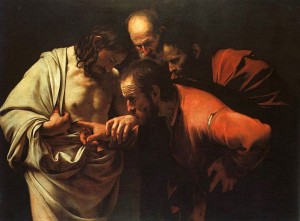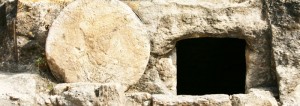‘Stop doubting and believe’ was Jesus’ command to Thomas as recorded in John’s gospel. Thomas had been absent when Jesus previously appeared to the disciples and he wasn’t going to believe without proof, ‘Unless I see the nail marks in his hands and put my finger where the nails were, and put my hand into his side, I will not believe.’ Many people have seen in this account an elevation of blind faith over faith based on evidence, especially when Jesus says ‘blessed are those who have not seen and yet have believed.’ Thomas was a rationally minded sceptic asking for proof; Jesus expected blind faith.
 Is that what was really going on here? It seems not. John states just after this incident that the very reason he wrote his gospel was so that people would believe that Jesus was the Son of God – not blind faith, but faith presumably based on the evidence of his account. The clear implication then is that Jesus thought Thomas was being unreasonable in his scepticism, that based on the evidence he had available to him he should have believed in the miracle of the resurrection.
Is that what was really going on here? It seems not. John states just after this incident that the very reason he wrote his gospel was so that people would believe that Jesus was the Son of God – not blind faith, but faith presumably based on the evidence of his account. The clear implication then is that Jesus thought Thomas was being unreasonable in his scepticism, that based on the evidence he had available to him he should have believed in the miracle of the resurrection.
But what does it take to believe in a miracle? How much evidence would be needed? Could it ever be reasonable to believe a miracle had actually taken place? I would suggest there are four considerations we need to bear in mind:
- Is there a God?
- What is the specific evidence for the miracle?
- Are there plausible alternative natural explanations?
- What is the context of the miracle? Would God have reason to bring it about?
Let’s take each of these in turn.
1. Is there a God?
If someone is certain there is no God, then it’s difficult to see how any amount of evidence could convince them that Jesus rose from the dead. That would effectively require demonstrating that Jesus rose naturally from the dead and that would be a tall order indeed! But Christians don’t believe that anyway! They believe that God raised Jesus from the dead. So does that mean you must believe in God already, before you could take the case for the resurrection seriously? No, that isn’t right either. Someone who doesn’t believe in God, but is not certain that God does not exist, can still consider the case for the resurrection. And fortunately there are virtually no atheists who would claim to be certain God does not exist. In fact, if the case for the resurrection is good, that can in turn make God’s existence more plausible for the person than it was to start with.
2. What is the specific evidence for the resurrection?
Some people think that you either accept the resurrection based on accepting the Bible as the word of God or you do not, simple as that. But that can’t be right; the earliest Christians didn’t believe it on that basis because the gospels hadn’t been written yet! No, they claimed to believe it on the basis of evidence, so what evidence was that? Perhaps surprisingly, there’s a lot we can know on good historical grounds about what took place after Jesus’ death. Even historians of a sceptical disposition don’t simply throw out the gospels as being of no historical value. The attempt to evaluate them as they would other historical documents and on that basis there are a range of well-supported facts (typically supported by multiple lines of evidence) that are relevant to our discussion. 18 have been listed in another article, but here I will focus on the following three facts (for the supporting evidence and discussion see this article):
i) the empty tomb (see the article Jesus’ Followers Discovered an Empty Tomb),
ii) multiple appearances took place in which many people who had known Jesus well believed they had seen him alive again,
iii) the disciples were not expecting Jesus to be resurrected.
 We could consider other facts such as that sceptics like Paul, who had persecuted Christians, became followers of Jesus and the origin of Christianity, including belief in the resurrection as a historical reality and the fact that many early Christians were willing to die for their beliefs. But for the first Christians the facts noted above are particularly relevant. Note that none of these facts are miraculous in nature and can be (and in fact are) supported by good evidence. Anyone who thinks that extraordinary claims require extraordinary evidence, should see an article on that topic. Straightforward evidence of the kind noted above can provide confirmation for the resurrection if the evidence is better explained by the resurrection hypothesis than be naturalistic alternatives.
We could consider other facts such as that sceptics like Paul, who had persecuted Christians, became followers of Jesus and the origin of Christianity, including belief in the resurrection as a historical reality and the fact that many early Christians were willing to die for their beliefs. But for the first Christians the facts noted above are particularly relevant. Note that none of these facts are miraculous in nature and can be (and in fact are) supported by good evidence. Anyone who thinks that extraordinary claims require extraordinary evidence, should see an article on that topic. Straightforward evidence of the kind noted above can provide confirmation for the resurrection if the evidence is better explained by the resurrection hypothesis than be naturalistic alternatives.
There is plenty of relevant evidence, but merely presenting evidence on its own is not enough to make the case for the resurrection. We also need to consider the following question.
3. Are there plausible alternative natural explanations?
At a popular level, some atheists seem to think that the evidence can easily be explained (or explained away) without appealing to the supernatural. Perhaps the disciples stole the body, or the women went to the wrong tomb, or Jesus didn’t die but revived in the tomb. However, these conspiracy theories have been dead and buried since the work of David Strauss in the 19th century. Strauss himself did not believe in miracles, but he decisively refuted these far-fetched, highly implausible conspiracy accounts. See No Conspiracy Theories Allowed for details.
Other natural explanations that are proposed don’t fare much better. For example, some suggest that the disciples had visions or hallucinations and over time this grew into the sorts of accounts we have in the gospels. But given the third piece of evidence noted earlier (that the disciples weren’t expecting a resurrection), hallucinations are implausible and visions wouldn’t have been interpreted that way in any case, never mind the fact that these approaches fail to account for the number and nature of appearances in the second piece of evidence. And they also leave the first piece of evidence (the empty tomb) unexplained, so that further implausible stories are needed to explain away the various lines of evidence for the empty tomb. See The Case for the Resurrection for some further discussion.
Given the weaknesses of these alternative natural explanations, it seems likely that what is really driving interest in these views is an underlying commitment that some natural explanation must be correct. Miracles simply cannot be countenanced. See The Fact of the Resurrection and the Faith of Historians for further discussion.
Rather than trying to deny the evidence for the resurrection or appeal to implausible alternative natural explanations, a better strategy for the sceptic would be to acknowledge that something took place that is both very unusual and inexplicable. Certainly for some miraculous claims that seems like a sensible approach. Even if the evidence seems robust and there is no natural explanation, maybe it was just a strange, unexplained occurrence. To make it reasonable to believe that a miracle occurred, we’d need to consider the context: is it the kind of event God would have reason to bring about? So that brings us to point 4.
4. What is the context of the miracle? Would God have reason to bring it about?
The context is the unique life, teaching and death of Jesus of Nazareth. By any reckoning, Jesus is a truly remarkable character. Despite never holding a position of political or religious power, never having written a book or having produced any works of art or music, he has had a greater influence on human history than anyone else who has ever lived. His life and teaching are held in high regard by people from a wide variety of perspectives including people with different religious beliefs as well as many atheists.
How plausible is the claim of Christians that Jesus is the unique Son of God? That is, of course, another discussion, but suffice it to say that if there is anyone in human history who could even be considered as a possible candidate it is Jesus of Nazareth. No-one else even comes close. In his book The Resurrection of God Incarnate, Richard Swinburne draws attention to the striking coincidence that the only prophet for whom there is significant evidence that he satisfied the requirements that he was God is also the only prophet about whom there is significant evidence for a resurrection having taken place.
This remarkable coincidence provides the context for considering the resurrection. If the evidence just concerned some completely unknown figure, we might say that something unusual happened and that we can’t explain it, but also that we fail to see why God would have raised the person from the dead – after all, God doesn’t usually do that kind of thing! But Jesus is different. Would it make sense if God raised Jesus from the dead? Yes, this would be a vindication of his message and demonstration that he was indeed the Son of God.
So if God’s existence cannot be ruled out (which it can’t), if there is good evidence (which there is) and if there are no plausible natural explanations (which there aren’t), the unique life, teaching and shameful death of Jesus provide the context that completes the case for the resurrection.
Thomas and Belief in the Resurrection
So was Thomas being reasonable in his scepticism? And is John’s gospel therefore encouraging blind faith? Let’s consider each of the four points from Thomas’ perspective. First, he clearly believed in God, so there is no difficulty on that point. Second, what about the specific evidence? According to John’s account (and confirmed by the other gospels), there were witnesses to the burial by Joseph of Arimathea and the empty tomb was discovered by women. So the evidence of i) the empty tomb would have been available to Thomas and he could have questioned the women and other disciples about it. In fact, since it would have been easy to check, it’s quite possible he visited he tomb himself. It’s also very evident from the text that he was aware of the evidence of ii) the appearances. As for the evidence that iii) the disciples were not expecting Jesus to be resurrected, clearly he wasn’t expecting it himself! And he would have known that the other disciples weren’t expecting it either. So Thomas would have had excellent evidence for the resurrection available to him.
 Third, were there any plausible natural explanations available to Thomas? No. Given the evidence available, conspiracy theories about the wrong tomb, the swoon theory or the disciples having stolen the body would have seemed even more ridiculous to him than they do to historians in the twenty-first century. And the evidence would also count strongly against visions or hallucinations, etc. Fourth, what about the context? Thomas had spent three years with the most remarkable person who has ever lived! He had first-hand experience of Jesus’ unique life and teaching. Thomas could not simply put it all down to an unexplained occurrence. Given all that Thomas knew about Jesus, the resurrection hypothesis would make perfect sense of all the evidence available.
Third, were there any plausible natural explanations available to Thomas? No. Given the evidence available, conspiracy theories about the wrong tomb, the swoon theory or the disciples having stolen the body would have seemed even more ridiculous to him than they do to historians in the twenty-first century. And the evidence would also count strongly against visions or hallucinations, etc. Fourth, what about the context? Thomas had spent three years with the most remarkable person who has ever lived! He had first-hand experience of Jesus’ unique life and teaching. Thomas could not simply put it all down to an unexplained occurrence. Given all that Thomas knew about Jesus, the resurrection hypothesis would make perfect sense of all the evidence available.
So based on the four considerations for evaluating a miracle, Thomas had a very strong case available to him. In demanding physical proof, Thomas was being unreasonable in his scepticism. He was going far beyond a request for reasonable evidence and instead adopting an attitude that showed an unwillingness to consider all the evidence that was already available to him, a mindset that prevented from seeing the truth.
What would Thomas say to us today? I strongly suspect that a few minutes after this incident, Thomas would have realised that in adopting his unreasonably sceptical stance, he had made the biggest mistake of his life. Fortunately, he had the opportunity to see Jesus and his doubt turned to belief and worship as he acknowledged Jesus as his Lord and God. But I imagine he would urge us not to make the same mistake that he made. We too have reasons to believe in God (see various articles here), we have plenty of specific evidence relating to the resurrection, no plausible natural explanations for this evidence, and plenty of evidence for the unique life of Jesus. So I think Thomas would plead with us not to miss the truth by demanding physical proof when good evidence is already available. He would tell us to ‘stop doubting and believe’.

